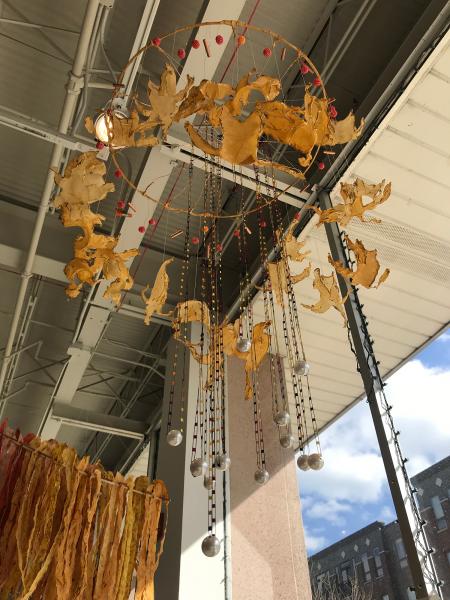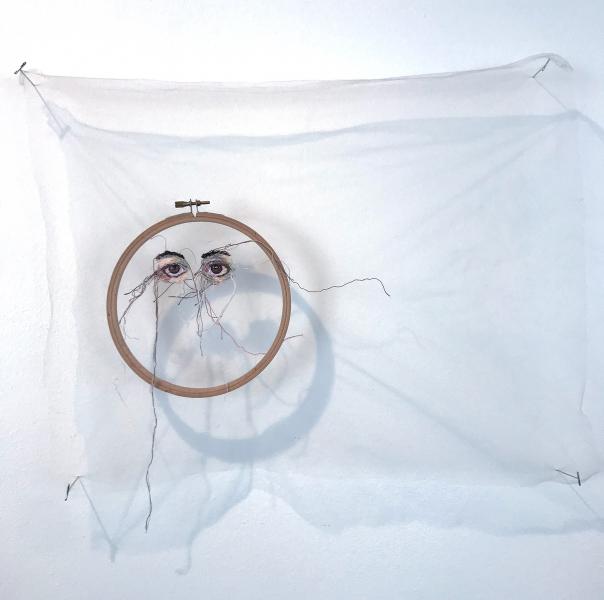
Learning to Fly, Number One,
2019
Laurie LeBreton’s new exhibit at the Art Center is whimsical yet technically intricate. Her mobile hanging series, Joyful Noise, consists of three beautiful and airy pieces. The middle work is shaped a bit like a jelly fish with beads hanging from multi-colored strands in the center of a ring. The movement in this piece as a whole almost makes you forget to inspect all of the smaller details that add to its complexity. The other two works in this series hold a similar animated quality. The long strands of handmade abaca paper in the farthest piece are also used in some of the artist’s larger works.
LeBreton’s larger pieces are composed of small patches of the abaca paper that are dyed mainly as neutral earth tones. By threading these individual pieces together, the artist creates something much more powerful. One of these works is called This One’s for All of Us. The title gives the impression that the message lies in collective efforts having more influence than individual efforts.
One such effort that LeBrenton seems to emphasize in her work is sustainability. One of the mobile pieces in the Joyful Noise series makes this especially evident. Made of repurposed aluminum cans and more handmade paper, this piece shows the beauty in reused materials. Overall, LeBreton’s work gets more and more captivating as each piece adds its own dimension to the installation as a whole.

Paula Froehle’s work on currently on display has an elegantly dark narrative, created with delicate materials and minimalistic compositions. The black thread weaved through transparent cloth resembles a fine line drawing. While each piece looks 2 dimensional from a far, the closer you get to the piece, the more it pops off the wall. The organic folds of the fabric add dimension to each piece, and contrast the harsh black thread. The natural sunlight from the windows hits each piece in such a way to create a shadow effect, adding depth and dimension to the piece. “Care” was the first piece that caught my eye. The expression in it really jumped out at me- it was a piece I had to stop and look at for a while to feel like I understood it. The way the mother is cradling her child with her eyes down reveals a sorrow that is only known to the mother. The child seems unaware of their mother’s pain, expressing how care is unconditional, and a parent has to be nurturing to their child no matter what mental state they are in. The shadow effect from the sunlight created a soft outline of the thread, contrasting the sharp, thin thread in front of it. I loved the vertical composition and minimalistic aesthetic it has- I can totally picture it as a wall hanging in a home.
Some of the smaller, circular pieces composed in circular wooden frames show only eyes on the cloth. These eye pieces are the only ones with color, making them striking and forcing the viewer to step closer and take in all of the details. This recurring theme makes me wonder what Froehle’s angle was with this choice, and got me thinking about how these eyes tie in to the rest of her work. It’s interesting because in the larger full body pieces, the eyes aren’t highlighted as a focal point- they’re even excluded from some of the pieces. I interpret this as the extent to which we allow ourselves to open up and be vulnerable. If eyes are the window to the soul, we have to pick and choose who we allow in.
I overall love Froehle’s style, and I would be curious to hear her speak about the narrative and emotion behind these works.

Give Me a Boat That Can Carry Two,
2017
Deborah Hirshfield’s stunning and unique use of fibers is what originally drew me into her exhibit. A running motif in the exhibit are the bodies constructed out of silk. These bodies, in combination with her other manipulation of materials, create an almost graphic feel to these 3D works, sparking a lot of intrigue within the viewer. This fabulously executed graphic quality also reinforces the emphasis on the themes Hirshfield is communicating.
Her work explores the ways in which gender and sex interact with power, and what that interaction means in relation to one’s autonomy. She is extremely skillful in her execution of both themes and visuals, consistently prompting the viewer to not only reflect upon their own experiences with gender and sex, but to dive further in that reflection. Her work leads to a contemplation of one’s own position of power and/or lack of power in a larger system that determines bodily autonomy. People in positions of privilege and power are awarded the ability to govern others’ bodies, and this power allows for others to be stripped of any control over their own body. Hirschfield’s work actively validates and empowers those who have had their autonomy stolen, and exposes the abuse of privilege and power that has enabled for this oppression to occur.

